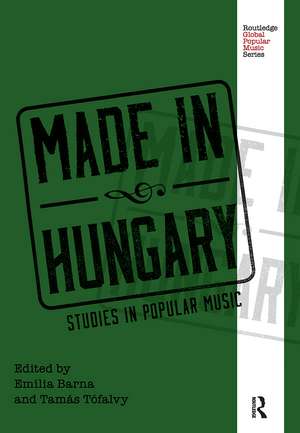Made in Hungary: Studies in Popular Music: Routledge Global Popular Music Series
Editat de Emília Barna, Tamás Tófalvyen Limba Engleză Hardback – 19 dec 2016
Tamás Tófalvy is Assistant Professor at the Budapest University of Technology and Economics. He was the founding Chair and is the current Vice-Chair of IASPM Hungary.
| Toate formatele și edițiile | Preț | Express |
|---|---|---|
| Paperback (1) | 258.50 lei 6-8 săpt. | |
| Taylor & Francis – 10 dec 2019 | 258.50 lei 6-8 săpt. | |
| Hardback (1) | 821.14 lei 6-8 săpt. | |
| Taylor & Francis – 19 dec 2016 | 821.14 lei 6-8 săpt. |
Din seria Routledge Global Popular Music Series
-
 Preț: 296.35 lei
Preț: 296.35 lei -
 Preț: 195.11 lei
Preț: 195.11 lei -
 Preț: 310.29 lei
Preț: 310.29 lei -
 Preț: 310.84 lei
Preț: 310.84 lei -
 Preț: 310.51 lei
Preț: 310.51 lei -
 Preț: 368.98 lei
Preț: 368.98 lei - 26%
 Preț: 850.59 lei
Preț: 850.59 lei - 16%
 Preț: 247.87 lei
Preț: 247.87 lei - 19%
 Preț: 245.56 lei
Preț: 245.56 lei - 17%
 Preț: 259.98 lei
Preț: 259.98 lei - 25%
 Preț: 823.57 lei
Preț: 823.57 lei -
 Preț: 397.87 lei
Preț: 397.87 lei - 21%
 Preț: 258.50 lei
Preț: 258.50 lei - 16%
 Preț: 273.44 lei
Preț: 273.44 lei - 20%
 Preț: 273.05 lei
Preț: 273.05 lei -
 Preț: 368.59 lei
Preț: 368.59 lei -
 Preț: 369.73 lei
Preț: 369.73 lei - 16%
 Preț: 248.97 lei
Preț: 248.97 lei - 17%
 Preț: 247.42 lei
Preț: 247.42 lei -
 Preț: 363.03 lei
Preț: 363.03 lei -
 Preț: 368.80 lei
Preț: 368.80 lei -
 Preț: 369.73 lei
Preț: 369.73 lei -
 Preț: 296.45 lei
Preț: 296.45 lei
Preț: 821.14 lei
Preț vechi: 1178.89 lei
-30% Nou
Puncte Express: 1232
Preț estimativ în valută:
157.17€ • 170.78$ • 132.11£
157.17€ • 170.78$ • 132.11£
Carte tipărită la comandă
Livrare economică 21 aprilie-05 mai
Preluare comenzi: 021 569.72.76
Specificații
ISBN-13: 9781138915879
ISBN-10: 1138915874
Pagini: 204
Ilustrații: 27
Dimensiuni: 174 x 246 x 17 mm
Greutate: 0.52 kg
Ediția:1
Editura: Taylor & Francis
Colecția Routledge
Seria Routledge Global Popular Music Series
Locul publicării:Oxford, United Kingdom
ISBN-10: 1138915874
Pagini: 204
Ilustrații: 27
Dimensiuni: 174 x 246 x 17 mm
Greutate: 0.52 kg
Ediția:1
Editura: Taylor & Francis
Colecția Routledge
Seria Routledge Global Popular Music Series
Locul publicării:Oxford, United Kingdom
Cuprins
Acknowledgments List of Illustrations Series Foreword Introduction: The Study of Popular Music in Hungary Part I: Scenes, Cultures and Identities 1. Setting Up a Tent in the "New Europe:" The Sziget Festival of Budapest 2. Taming the Extreme: Hungarian Black Metal in the Mainstream Publicity 3. Learned Helplessness of a Cultural Scene: The Hungarian Contemporary Jazz Scene through the Eyes of Its Participants 4. A Translocal Music Room of One’s Own: Female Musicians within the Budapest Lo-Fi Music Scene Part II: History, Politics and Remembering 5. The Songs Remain the Same: Structures of Cultural Politics of Retro in Hungarian Pop Music 6. “Hungarian in Form, Socialist in Content:” The Concept of National Dance Music in Stalinist Hungary 7. Paper Mohawk: On a Missing Hungarian Punk Monograph 8. “Nothing But the Music … :” The History of Hungarian Funk Music Part III: Artists, Receptions and Audiences 9. The Insecure Village Girl Who Found Success, and Her Gentle Deconstructions: Bea Palya 10. “Gloomy Sunday:” The Hungarian “Suicide Hymn” between the Myths and Interpretations 11. “This Kind of Music Informs You about the Present State of the World:” DJ Palotai’s Position within the Contemporary Hungarian Underground Culture 12. The Way They Were: Subcultural Experiences of Emo Fans from a Retrospective Aspect 13. The Growth of the Hungarian Popular Music Repertoire: Who Creates It and How does It Find an Audience? 14. Coda: “My Genes in My Suitcase, My Forehead in the Atmosphere:” Perceptions of Hungarian Popular Music and Its Research Abroad Afterword: “A Dozen Songs Put in the Right Order:” A Conversation with Yonderboi Select Bibliography of Hungarian Popular Music Notes on Contributors Index
Notă biografică
Emília Barna is Assistant Professor at the Budapest University of Technology and Economics. She is a founding member and Chair of IASPM Hungary, editor of Zenei Hálózatok Folyóirat (Music Networks Journal), and Advisory Board Member of IASPM@Journal.
Tamás Tófalvy is Assistant Professor at the Budapest University of Technology and Economics. He was the founding Chair and is the current Vice-Chair of IASPM Hungary.
Tamás Tófalvy is Assistant Professor at the Budapest University of Technology and Economics. He was the founding Chair and is the current Vice-Chair of IASPM Hungary.
Descriere
Made in Hungary: Studies in Popular Music serves as a comprehensive and thorough introduction to the history, sociology, and musicology of twentieth-century Hungarian popular music. The volume consists of essays by scholars of Hungarian music, and covers the major figures, styles, and social contexts of pop music in Hungary. Each essay provides adequate context so readers understand why the figure or genre under discussion is of lasting significance to Hungarian popular music. The book first presents a general description of the history and background of popular music in Hungary, followed by essays that are organized into thematic sections: Scenes, Culture and Identities; History, Politics and Remembering; and Artists, Receptions and Audiences.











